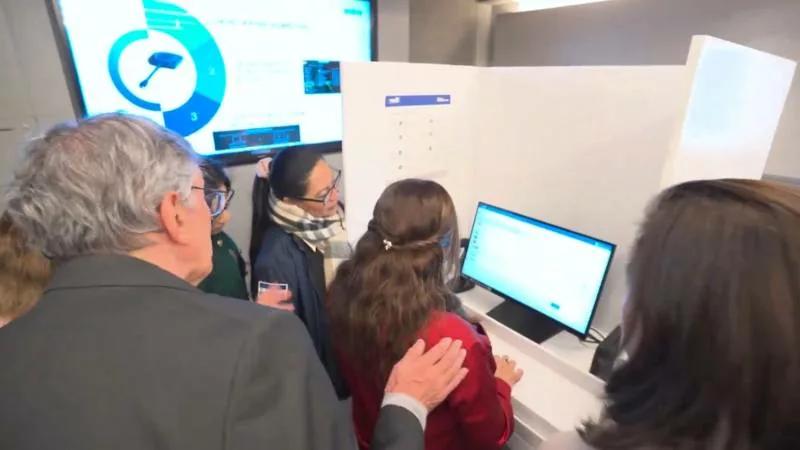The Supreme Electoral Tribunal (TSE) has taken a step back and decided to once again omit the use of the biometric system for in-person electronic voting.
The presiding magistrate, Dora Esmeralda Martínez, announced this Tuesday that Salvadorans who are due to vote in person on February 4th, because their address is within the national borders, will not have to go through that phase in their voting process.
“The in-person vote will not have biometrics, because they are only going to have one day to vote. And not only that, the law does not require biometric verification for in-person electronic voting,” explained the president.
“We did the analysis, together with the technicians, the head of the Computer Systems Unit, it was said to us that it is only one day, there could be a problem like the one we are having in recognition,” she detailed.
According to Martínez, it could happen that there are passports issued since the person was a minor, and that could be a problem in the biometric recognition phase. In addition, she assured that it is not a necessary process.
The president explained that the voting center abroad will be made up of three people, who will look for him in the electoral register, and the identity document (DUI/PASSPORT) will be verified with the person present.
“I keep my passport from 2006, but if someone tells me they want to see my passport to see if I am the same person, of course, I am young there, but it can be seen that I am the same person,” exemplified the president.
“The biometric was going to cause longer lines, it was going to cause some problem,” she justified in her live social media broadcast.
TSE’s Biometric Juggling
On December 21st, magistrate Julio Olivo revealed that four members of the collegiate body had decided to eliminate biometric verification for in-person electronic voting, which is the one that will be cast by people who have their address in the national territory on their Unique Identity Document (DUI) or their passport. According to Olivo, even the auditing firm of the process questioned that decision.
The Tribunal received remarks from candidates for popular election positions and from electoral experts; therefore, it seems that they had taken the word of the critical voices and of the electronic voting executing company INDRA and agreed to use it again.
It was on December 28th when the TSE revealed that it had agreed to implement biometric verification for in-person electronic voting.
This time, the Tribunal had not disclosed that it had once again removed the verification tool from the presidential voting of the diaspora.
TSE vuelve a quitar biometría para voto electrónico presencial
El Tribunal Supremo Electoral (TSE) dio un paso atrás y decidió nuevamente omitir el uso del sistema biométrico para el voto electrónico presencial.
La magistrada presidenta Dora Esmeralda Martínez anunció este martes que las y los salvadoreños que les corresponde votar el 4 de febrero de manera presencial, por tener su dirección dentro de las fronteras nacionales, no deberán realizar dicha fase en su proceso de votación.
“El voto presencial no va a tener biometría, porque solo van a tener un día para votar. Y no solo eso, la ley no requiere para voto presencial electrónico que vaya biométrico”, explicó la presidenta.
“Hicimos los análisis, conjuntamente con los técnicos, el jefe de la Unidad de Sistemas Informáticos, se nos decía que solo es un día, puede haber un problema así como el que estamos teniendo en el reconocimiento”, detalló.
Según Martínez puede ocurrir que haya pasaportes emitidos desde que la persona era menor de edad y eso podría ser un problema en la fase del reconocimiento biométrico. Además, aseguró que no es un proceso necesario.
La presidenta explicó que el centro de votación en el exterior estará conformado por tres personas, quienes lo buscarán en el registro electoral, se verificará con la persona presente su documento de identidad (DUI/PASAPORTE).
“Yo conservo mi pasaporte de 2006, pero si alguien me dice que quiere ver mi pasaporte para ver si soy la misma persona, claro que estoy joven ahí, pero se logra visualizar que soy la misma persona”, ejemplificó la presidenta.
“El biométrico lo que iba a causar era generar más largas colas, iba a generar algún problema”, justificó en su transmisión en vivo de redes sociales.
Biometría en malabares del TSE
El pasado 21 de diciembre, el magistrado Julio Olivo reveló que cuatro magistrados del organismo colegiado habían decidido eliminar la verificación biométrica para el voto electrónico presencial, que es el que emitirán las personas que tengan en su Documento Único de Identidad (DUI) o su pasaporte su domicilio en el territorio nacional. Según Olivo, incluso la firma auditora del proceso cuestionó dicha decisión.
El Tribunal recibió señalamientos de parte de candidatos y candidatas a cargos de elección popular y de parte de expertas y expertos electorales; por lo que, al parecer, habían tomado la palabra de las voces críticas y de la empresa ejecutora del voto electrónico INDRA y volvieron a acordar utilizarlo.
Fue el pasado 28 de diciembre cuando el TSE reveló que había acordado que sí implementará la verificación biométrica para el voto electrónico presencial.
Esta vez, el Tribunal no había revelado que volvió a quitar la herramienta de verificación a la votación presencial de la diáspora.

